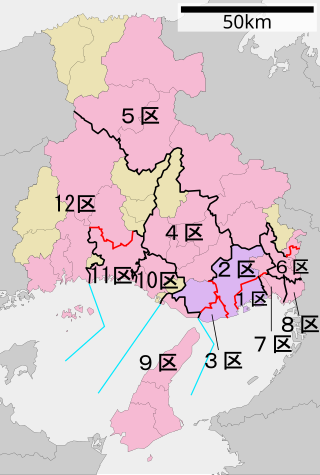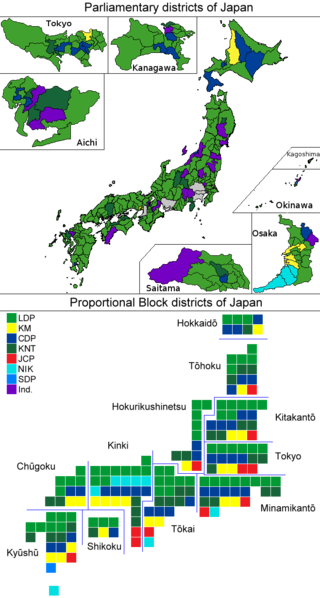| Northern Japan |
|---|
| Prefecture | Seats up | Incumbents | Party | Result | Candidates
(Party)
Vote share |
|---|
| Hokkaidō | 2 | Hisamitsu Kanno | DPJ | Incumbent re-elected
Incumbent retired
LDP pickup
LDP gains top tōsen | | Chūichi Date (LDP) 39.3%
Katsuya Ogawa (DPJ) 27.2%
Satoshi Miyauchi (JCP) 11.3%
Masahito Nishikawa (LP) 7.8%
Yoshiko Sugiyama (SDP) 6.6%
Tamiko Matsumura (WP) 3.5%
Mitsuhiro Yokoyama (I) 1.4%
Akifumi Kumagai (LL) 1.3%
Nobuyuki Saitō (NSP) 1.0%
Nobuhito Sendai (Ishin) 0.5% |
| Katsuya Ogawa | DPJ | |
| Aomori | 1 | Tsutomu Yamazaki | LDP | Incumbent re-elected | | Tsutomu Yamazaki (LDP) 53.7%
Hideshige Sasaki (I) 18.9%
Isamu Moriuchi (I) 18.8%
Hiroaki Takayanagi (JCP) 6.0%
Kyōko Murata (LL) 2.6% |
| Iwate | 1 | Yoshinori Takahashi | LP | Incumbent retired
LP hold | | Tatsuo Hirano (LP) 41.9%
Tokuichirō Tamazawa (LDP) 41.1%
Kazue Yabuki (SDP) 8.8%
Norikatsu Sugawara (JCP) 6.1%
Riki Ishiwatari (LL) 2.2% |
| Miyagi | 2 | Tomiko Okazaki | DPJ | DPJ incumbent re-elected
LDP incumbent lost re-election
LDP hold | | Tomiko Okazaki (DPJ) 32.2%
Jirō Aichi (I – LDP, Kōmeitō, CP) 27.5%
Hiroaki Kameya (LDP) 25.9%
Masatoshi Yoshida (SDP) 6.1%
Toshirō Ono (JCP) 5.9%
Kiyoharu Satō (LL) 2.3% |
| Hiroaki Kameya | LDP | |
| Akita | 1 | Katsutoshi Kaneda | LDP | Incumbent re-elected | | Katsutoshi Kaneda (LDP) 54.2%
Kazuo Takamatsu (DPJ) 17.9%
Nagahide Sasaki (SDP) 14.6%
Toshio Suzuki (JCP) 8.0%
Sachiko Saitō (LL) 5.2% |
| Yamagata | 1 | Masatoshi Abe | LDP | Incumbent re-elected | | Masatoshi Abe (LDP) 51.5%
Kanji Kimura (I) 36.1%
Toshio Ōta (JCP) 6.4%
Fumiyuki Monma (LL) 3.6%
Tsuneyoshi Chiba (NSP) 2.4% |
| Fukushima | 2 | Toyoaki Ōta | LDP | Incumbents re-elected | | Toyoaki Ōta (LDP) 40.5%
Hiroko Wada (DPJ) 22.7%
Kaori Kanda (I) 11.7%
Keiichi Miho (I) 9.8%
Masanari Kawada (LP) 7.3%
Masayo Niimi (JCP) 6.2%
Takao Suzuki (LL) 1.8% |
| Hiroko Wada | DPJ | |
| Eastern and Central Japan |
|---|
| Prefecture | Seats up | Incumbents | Party | Result | Candidates
(Party – endorsements)
Vote share |
|---|
| Ibaraki | 2 | Yasu Kanō | LDP | Incumbents re-elected | | Yasu Kanō (LDP) 49.3%
Moto Kobayashi (DPJ) 23.3%
Masako Katō (LP) 10.4%
Toyomasa Komatsu (JCP) 6.1%
Mariko Yoshioka (WP) 5.7%
Hiromitsu Mutō (LL) 2.8%
Hiroyuki Sugimori (NSP) 2.4% |
| Moto Kobayashi | DPJ | |
| Tochigi | 2 | Junzō Iwasaki | LDP | Incumbent re-elected
Incumbent retired
DPJ pickup | | Masayuki Kunii (LDP) 38.6%
Hiroyuki Tani (DPJ) 28.0%
Toshikazu Masabuchi (I) 24.3%
Setsuko Nomura (JCP) 5.5%
Mayumi Yotsumoto (LL) 2.2%
Morio Asai (NSP) 1.3% |
| Masayuki Kunii | LDP | |
| Gunma | 2 | Ichita Yamamoto | LDP | Incumbents re-elected | | Ichita Yamamoto (LDP) 40.4%
Giichi Tsunoda (DPJ) 27.8%
Mayumi Yoshikawa (LDP) 24.7%
Shinmei Ogasawara (JCP) 5.1%
Haruyo Tsuchiya (LL) 2.1% |
| Giichi Tsunoda | DPJ | |
| Saitama | 3 | Hiroshi Takano | Kōmeitō | Kōmeitō and LDP incumbents re-elected
LDP gains top tōsen
JCP incumbent lost re-election
DPJ pickup | | Taizō Satō (LDP) 25.3%
Hiroshi Takano (Kōmeitō) 20.2%
Ryūji Yamane (DPJ) 15.1%
Sachiko Abe (JCP) 13.5%
Yasuko Komiyama (LP) 12.4%
Chūkō Hayakawa (I) 4.5%
Takeo Amatatsu (SDP) 3.9%
Hiroko Hayashi (LL) 2.4%
Takuya Ogawa (I) 0.9%
Morio Katō (I) 0.7%
Setsuo Yamaguchi (I) 0.5%
Fumikazu Murata (NSP) 0.4%
Masakazu Imazawa (Ishin) 0.2% |
| Taizō Satō | LDP | |
| Sachiko Abe | JCP | |
| Chiba | 2 | Akira Imaizumi | DPJ | Incumbents re-elected
LDP gains top tōsen | | Hiroyuki Kurata (LDP) 43.8%
Akira Imaizumi (DPJ) 16.3%
Kazumasa Okajima (LP) 15.9%
Tomoko Hoshino (I) 10.1%
Makoto Nakajima (JCP) 9.0%
Yumiko Nakaue (LL) 3.3%
Hirokuni Osanami (NSP) 1.5% |
| Hiroyuki Kurata | LDP | |
| Tokyo | 4 | Yūichirō Uozumi | Kōmeitō | LDP and JCP incumbents re-elected
Kōmeitō and SDP incumbent retired
Kōmeitō hold
LDP gains top tōsen
DPJ pickup | | Sanzō Hosaka (LDP) 27.9%
Natsuo Yamaguchi (Kōmeitō) 17.5%
Kan Suzuki (DPJ) 15.1%
Yasuo Ogata (JCP) 12.5%
Nobuhiko Endō (LP) 7.2%
Kei Hata (I) 4.2%
Tetsu Ueda (I) 4.2%
Chizuko Koroiwa (I) 3.3%
Sadaharu Hirota (SDP) 3.2%
Itaru Kobayashi (LL) 2.1%
Hanako Igarashi (WP) 1.8%
Shigeo Arakaki (I) 0.6%
Chōzō Nakagawa (I) 0.3 %
Hisatoshi Hashimoto (Ishin) 0.2%
Toshirō Saitō (I) 0.2% |
| Sanzō Hosaka | LDP | |
| Yasuo Ogata | JCP | |
| Hideo Den | SDP | |
| Kanagawa | 3 | Akira Matsu | Kōmeitō | DPJ and Kōmeitō incumbents re-elected
LDP incumbent retires
LDP hold
LDP gains top tōsen | | Yutaka Kobayashi (LDP) 35.4%
Akira Matsu (Kōmeitō) 18.0%
Tsuyoshi Saitō (DPJ) 16.3%
Keiko Ueda (SDP) 8.4%
Masataka Ōta (LP) 8.4%
Hiroyuki Muneta (JCP) 8.2%
Eriko Kurata (WP) 2.2%
Hirohisa Miwa (LL) 1.5%
Ranko Kawamura (I) 0.8%
Yoshiko Bannai (NSP) 0.4%
Takeshi Miwa (Ishin) 0.4% |
| Kiyoharu Ishiawata | LDP | |
| Tsuyoshi Saitō | DPJ | |
| Niigata | 2 | Yoshio Yoshikawa | LDP | Incumbent retired
Incumbent lost re-election
LDP hold
LP pickup | | Kazuo Majima (LDP) 35.7%
Yūko Mori (LP) 14.9%
Junko Uchida (SDP) 14.2%
Nobuyuki Sekiyama (DPJ) 14.2%
Michio Hasegawa (I) 13.8%
Kayoko Kuwahara (JCP) 6.2%
Nobuaki Shinozaki (LL) 0.8% |
| Michio Hasegawa | LDP | |
| Toyama | 1 | Yasumasa Kakuma | LDP | Incumbent retired
LDP hold | | Kōtarō Nogami (LDP) 65.8%
Yasuharu Kusajima (I) 24.3%
Hiroshi Sakamoto (JCP) 7.1%
Kazue Kubokawa (LL) 2.8% |
| Ishikawa | 1 | Tetsuo Kutsukake | LDP | Incumbent re-elected | | Tetsuo Kutsukake (LDP) 57.0%
Chieko Morioka (I) 33.3%
Yōko Onishi (JCP) 6.7%
Hideyuki Tanabe (LL) 2.9% |
| Fukui | 1 | Ryūji Matsumura | LDP | Incumbent re-elected | | Ryūji Matsumura (LDP) 63.0%
Kikuko Ozawa (DPJ) 27.2%
Kunihiro Uno (JCP) 7.2%
Tōru Yamaguchi (LL) 2.6% |
| Yamanashi | 1 | Mahito Nakajima | LDP | Incumbent re-elected | | Mahito Nakajima (LDP) 48.6%
Yūichi Higuchi (DPJ) 33.5%
Akiko Endō (JCP) 8.0%
Hiroshi Shōji (LP) 7.6%
Chihoko Katō (LL) 2.3% |
| Nagano | 2 | Mineo Koyama | DPJ | Incumbent re-elected
Incumbent lost re-election
LDP pickup
LDP gains top tōsen | | Hiromi Yoshida (LDP) 32.9%
Yūichirō Hata (DPJ) 27.8%
Mineo Koyama (DPJ) 16.8%
Norihisa Yamaguchi (JCP) 11.1%
Setsuko Satō (SDP) 9.0%
Nobuyuki Watanabe (LL) 2.4% |
| Yūichirō Hata | DPJ | |
| Gifu | 2 | Tsuyako Ōno | LDP | Incumbents re-elected | | Tsuyako Ōno (LDP) 55.4%
Kenji Hirata (DPJ) 30.4%
Takao Katō (JCP) 10.4%
Michiko Higuchi (LL) 3.8% |
| Kenji Hirata | DPJ | |
| Shizuoka | 2 | Masataka Suzuki | LDP | Incumbent re-elected
Incumbent lost re-election
DPJ pickup | | Yutaka Takeyama (LDP) 31.7%
Kazuya Shinba (DPJ) 27.5%
Masataka Suzuki (LDP) 22.1%
Yukihiro Shimazu (JCP) 8.3%
Hiroko Suzuki (WP) 5.5%
Naoko Hara (LL) 4.8% |
| Yutaka Takeyama | LDP | |
| Aichi | 3 | Tamotsu Yamamoto | Kōmeitō | LDP and Kōmeitō incumbents re-elected
LDP incumbent retired
LDP gains top tōsen
DPJ pickup | | Seiji Suzuki (LDP) 34.6%
Kōhei Ōtsuka (DPJ) 23.5%
Tamotsu Yamamoto (Kōmeitō) 17.8%
Aiko Saitō (JCP) 9.9%
Masayuki Miyata (LP) 4.7%
Hiroaki Sago (SDP) 2.9%
Fusarō Sekiguchi (I) 1.5%
Kiyoko Osada (LL) 1.0%
Hachirō Ishikawa (LP) 0.7%
Tsutomu Suzuki (I) 0.6%
Reiko Yasuda (I) 0.5%
Kenji Sasaki (I) 0.4%
Akihiko Ishikawa (I) 0.3%
Yoshiaki Yamazaki (I) 0.3%
Yasuo Okayasu (NLP) 0.3%
7 other candidates 1.0% |
| Seiji Suzuki | LDP | |
| Makiko Suehiro | LDP | |
| Mie | 1 | Chiaki Takahashi | Independent | Incumbent re-elected | | Chiaki Takahashi (I) 46.5%
Kazumi Fujioka (LDP) 43.5%
Miyoshi Taninaka (JCP) 7.0%
Tōru Ishitani (LL) 3.1% |
| Western Japan |
|---|
| Prefecture | Seats up | Incumbents | Party | Result | Candidates
(Party – endorsements)
Vote share |
|---|
| Shiga | 1 | Hidetoshi Yamashita | LDP | Incumbent re-elected | | Hidetoshi Yamashita (LDP) 55.0%
Shun'yū Norikumo (DPJ) 27.9%
Takaishi Kawauchi (JCP) 11.3%
Midori Kitada (LL) 5.8% |
| Kyōto | 2 | Yoshihiro Nishida | LDP | LDP incumbent re-elected
Independent incumbent lost re-election
Democratic hold | | Yoshihiro Nishida (LDP) 38.5%
Kōji Matsui (DPJ) 23.5%
Yōko Kawakami (JCP) 22.1%
Teiko Sasano (I) 12.6%
Kaori Endō (LL) 3.3% |
| Teiko Sasano | Independent | |
| Ōsaka | 3 | Kazuyoshi Shirahama | Kōmeitō | LDP and Kōmeitō incumbents re-elected
JCP incumbent lost re-election
LDP gains top tōsen
DPJ pickup | | Shūzen Tanigawa (LDP) 26.6%
Kazuyoshi Shirahama (Kōmeitō) 24.7%
Takashi Yamamoto (DPJ) 17.2%
Yoshiki Yamashita (JCP) 17.0%
Yoshihiko Watanabe (LP) 5.6%
Takahiro Kitaoka (Koizumi no Kai) 3.3%
Kazuko Doi (WP) 2.9%
Tomohiko Ōkawa (LL) 1.0%
Keiji Kashimoto (NSP) 0.7%
Kyōsuke Morimoto (I) 0.7%
Ryūichi Nakatani (Ishin) 0.3% |
| Yoshiki Yamashita | JCP | |
| Shūzen Tanigawa | LDP | |
| Hyōgo | 2 | Ichiji Ishii | LL | LL incumbent retired
LDP incumbent re-elected
LDP gains top tōsen
DPJ pickup | | Yoshitada Kōnoike (LDP) 39.3%
Yasuhiro Tsuji (DPJ) 23.7%
Junko Hiramatsu (JCP) 14.3%
Kunihiko Muroi (LP) 9.3%
Aiko Takada (WP) 6.1%
Keiji Ueno (NSP) 3.1%
Toyoaki Tagawa (LL) 2.3%
Shōhei Fujiki (I) 1.9% |
| Yoshitada Kōnoike | LDP | |
| Nara | 1 | Yukihisa Yoshida | DPJ | Incumbent retired
LDP pickup | Shōgo Arai (LDP) 43.9%
Takeshi Maeda (DPJ) 39.2%
Shōji Kamano (JCP) 8.2%
Yukiko Sugita (SDP) 6.6%
Yasuhiro Okai (LL) 2.2% |
| Wakayama | 1 | Hiroshige Sekō | LDP | Incumbent re-elected | | Hiroshige Sekō (LDP) 67.7%
Fuminori Kimura (DPJ) 14.7%
Yasuhisa Hara (JCP) 13.7%
Toyoko Nishioka (LL) 3.9% |
| Tottori | 1 | Takayoshi Tsuneda | LDP | Incumbent re-elected | | Takayoshi Tsuneda (LDP) 56.5%
Makoto Satō (DPJ) 22.4%
Tomoko Ichitani (JCP) 10.9%
Satomi Yamamoto (SDP) 7.0%
Masashi Yamaguchi (LL) 3.2% |
| Shimane | 1 | Shuntarō Kageyama | LDP | Incumbent re-elected | | Shuntarō Kageyama (LDP) 68.1%
Kazuhisa Hamaguchi (DPJ) 18.7%
Katsuhiko Gotō (JCP) 9.1%
Junko Nakashima (LL) 4.0% |
| Okayama | 1 | Toranosuke Katayama | LDP | 1 seat lost by reapportionment
LDP incumbent re-elected
DPJ incumbent lost re-election | | Toranosuke Katayama (LDP) 61.0%
Mie Ishida (DPJ) 28.8%
Hisaki Moriwaki (JCP) 8.2%
Keiko Asawa (LL) 2.0% |
| Yukihisa Yoshida | DPJ |
| Hiroshima | 2 | Kensei Mizote | LDP | LDP incumbent re-elected
DPJ incumbent lost re-election
LDP pickup | | Takeaki Kashimura (I) 36.4%
Kensei Mizote (LDP) 31.9%
Kenji Sugekawa (DPJ) 17.0%
Kimiko Kurihara (NSP) 6.5%
Satoshi Fujimoto (JCP) 6.1%
Hidemi Yamada (LL) 2.0% |
| Kenji Sugekawa | DPJ | |
| Yamaguchi | 1 | Yoshimasa Hayashi | LDP | Incumbent re-elected | | Yoshimasa Hayashi (LDP) 61.4%
Susumu Iwamoto (DPJ) 25.5%
Tomoyuki Uonaga (JCP) 9.3%
Tadao Sasaki (LL) 2.2%
Tsuyoshi Nakashima (Ishin) 1.5% |
| Tokushima | 1 | Shūji Kitaoka | LDP | Incumbent re-elected | | Shūji Kitaoka (LDP) 54.3%
Kiyoshi Kimura (DPJ) 31.8%
Hitoshi Fujita (JCP) 7.2%
Chiyoko Takagai (NSP) 5.4%
Kōichi Maekawa (LL) 1.3% |
| Kagawa | 1 | Kenji Manabe | LDP | Incumbent re-elected | | Kenji Manabe (LDP) 62.1%
Midori Nagura (I) 18.9%
Yōko Shirakawa (JCP) 14.2%
Mie Tanaka (LL) 4.9% |
| Ehime | 1 | Katsutsugu Sekiya | LDP | Incumbent re-elected | | Katsutsugu Sekiya (LDP) 61.0%
Takashi Shimakawa (I) 25.8%
Hisao Yamamoto (JCP) 8.4%
Yoshiko Oguri (LL) 4.8% |
| Kōchi | 1 | Kōhei Tamura | LDP | Incumbent re-elected | | Kōhei Tamura (LDP) 40.0%
Hajime Hirota (I) 30.3%
Kumi Nakamura (DPJ) 16.6%
Sachi Nakane (JCP) 12.1%
Kiyotaka Maeda (LL) 0.9% |
| Southern Japan |
|---|
| Prefecture | Seats up | Incumbents | Party | Result | Candidates
(Party – endorsements)
Vote share |
|---|
| Fukuoka | 2 | Kentarō Koba | Kōmeitō | Kōmeitō incumbent retired
SDP incumbent lost re-election
LDP pickup | Masaji Matsuyama (LDP) 30.6%
Tsukasa Iwamoto (DPJ) 16.7%
Chū Furukawa (I) 16.3%
Shigeko Mieno (SDP) 12.7%
Jun'ichirō Koga (LP) 10.3%
Toyoomi Tsuno (JCP) 7.9%
Yukimi Kamemoto (WP) 3.9%
Miyoko Jōno (LL) 1.6% |
| Shigeko Mieno | SDP | LDP gains top tōsen
DPJ pickup |
| Saga | 1 | Takao Jinnouchi | LDP | Incumbent re-elected | | Takao Jinnouchi (LDP) 65.0%
Yasuhiro Fujino (DPJ) 23.2%
Yasutoshi Kamimura (JCP) 7.3%
Yasuhiro Fukagawa (LL) 4.5% |
| Nagasaki | 1 | Tadashi Taura | LDP | Incumbent re-elected | | Tadashi Taura (LDP) 53.4%
Yūji Mitsuno (I) 29.3%
Kōtarō Tanaka (I) 6.9%
Kimiko Ogawa (JCP) 6.6%
Sachiko Matsumoto (LL) 3.8% |
| Kumamoto | 1 | Hirohide Uozumi | Independent | 1 seat lost by reapportionment
Independent incumbent retired
LDP incumbent re-elected | | Issei Miura (LDP) 55.5%
Mariko Kōyama (DPJ) 34.8%
Etsuko Nishikawa (JCP) 5.4%
Kazuo Misumi (LL) 2.5%
Hirofumi Ishida (NSP) 1.8% |
| Issei Miura | LDP |
| Ōita | 1 | Keigi Kajiwara | SDP | Incumbent lost re-election
LDP pickup | Hiroko Gotō (LDP) 49.4%
Keigi Kajiwara (SDP) 43.4%
Masami Doi (JCP) 5.2%
Kayoko Kōno (LL) 2.1% |
| Miyazaki | 1 | Motoi Nagamine | LDP | Incumbent lost re-election
LDP hold | | Toshifumi Kosehira (LDP) 35.3%
Haruo Higashi (I) 30.5%
Motoi Nagamine (I) 27.5%
Hiromitsu Baba (JCP) 4.1%
Yutaka Kohata (LL) 2.6% |
| Kagoshima | 1 | Kaname Kamada | LDP | 1 seat lost by reapportionment
Incumbents retired
LDP hold | | Yoshito Kajiya (LDP) 55.7%
Masahiro Futamure (I) 27.9%
Mitsuhiro Yanagida (I) 7.4%
Haruki Yamaguchi (JCP) 4.7%
Kyōko Hata (NSP) 4.2% |
| Wataru Kubo | DPJ |
| Okinawa | 1 | Teruya Kantoku | Independent | Incumbent lost re-election
LDP pickup | Junshirō Nishime (LDP – Kōmeitō, CP) 47.7%
Teruya Kantoku (I – DPJ, LP, SDP, OSMP, LL) 44.0%
Sōgi Kayō (JCP) 8.3% |













